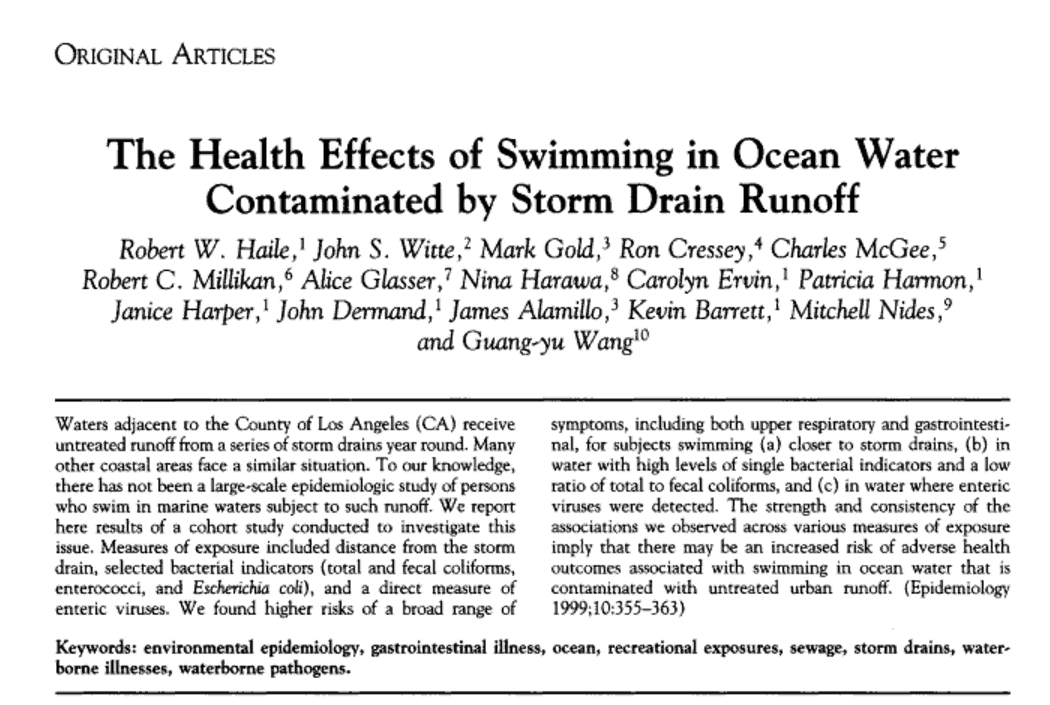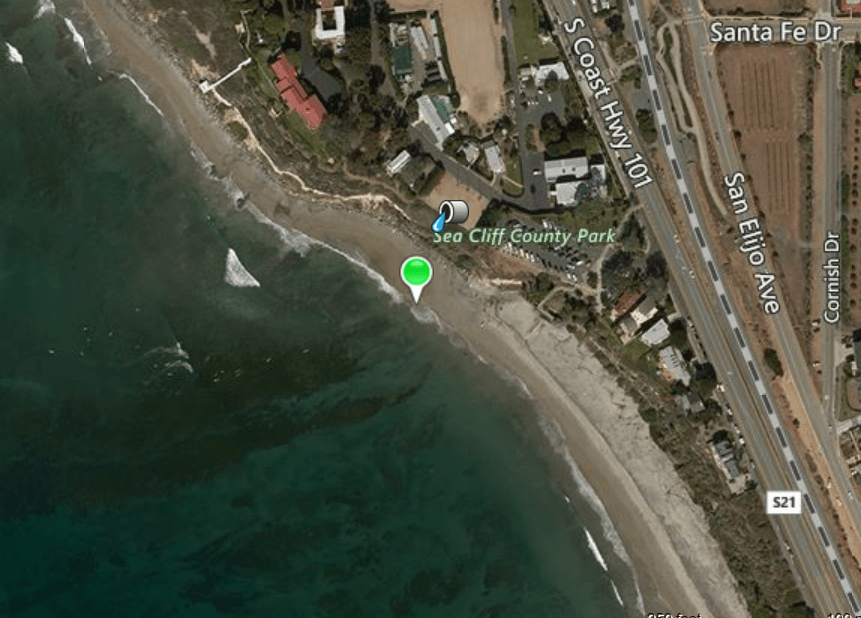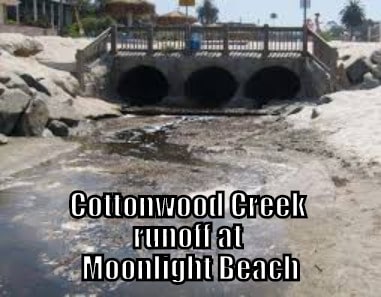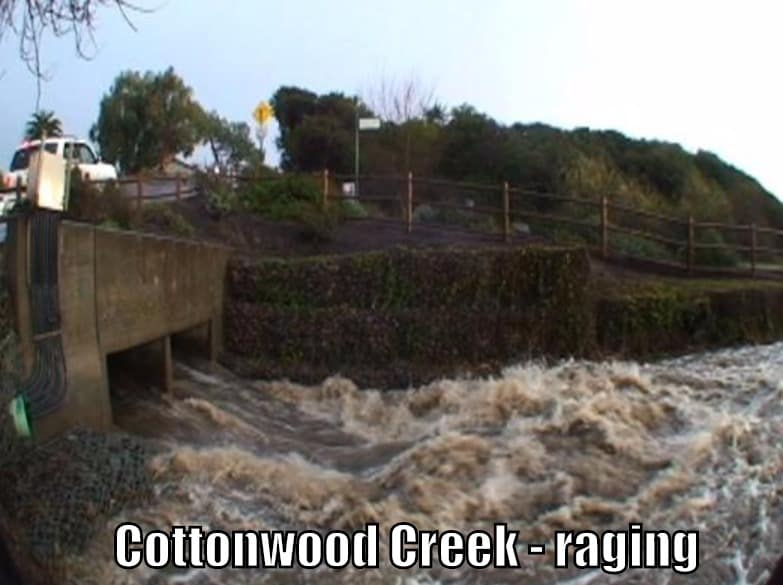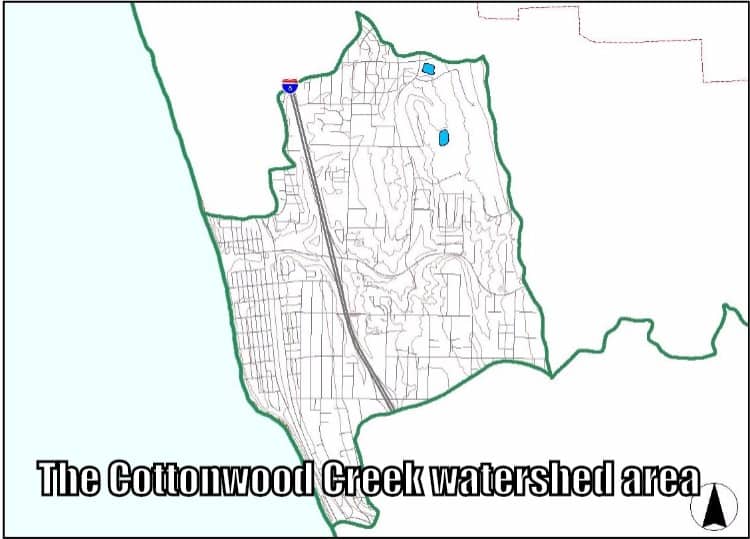Cottonwood Creek – The Short Version First – Stay Out Of The Water When It Rains. (images include Batiquitos Lagoon and Swami’s)
Just so you don’t have to read much more, here is the rule of thumb: If it is raining or rained over the past few days, stay out of the water because all the ‘crud’ in our community such as trash, dog waste, lawn chemicals, car oil and more run down Cottonwood Creek and empty into the ocean at Moonlight Beach. The San Diego County Department of Environmental Health advises the public to avoid contact with ocean and bay waters for 72 hours after it rains. Here is a San Diego County Beach Status Report – updated. You will see reports such as, ” Bacteria levels exceed health standards. Avoid contact with the water.”
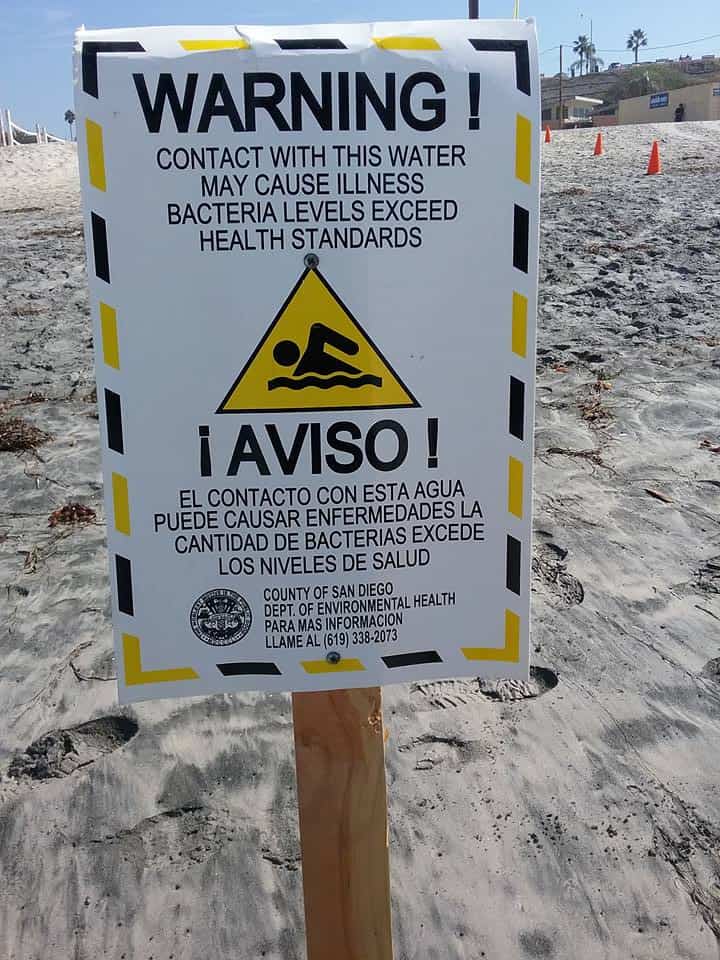 Look closely at the background and you will recognize Moonlight Beach
Look closely at the background and you will recognize Moonlight Beach
Photo by Marcos Palmichal
Please share with an ocean-going friend.
Some readers prefer scientific studies to substantiate that urban runoff can human illness – here you go…
Paved Paradise And Put Up A Parking Lot (see bonus at the bottom of this post) – Why You Should Care About Urban Runoff Pollution
Urban runoff is the single biggest threat to water quality in San Diego.
Here is why it is such a problem… We paved over much of the watershed area. Before water could soak into the ground. Now the meets parking lots, roads and buildings, cause water to flow over the surface and become stormwater or urban runoff, causes problems in our creeks, rivers and lagoons including increased pollution, faster and flashier flows and increased erosion.
During our long dry season, pollutants build on hard surfaces. When it rains, stormwater pushes the accumulated pollutants into our storm drains. In San Diego, like most of California, our storm drains generally do not connect to wastewater treatment plants, so everything flows untreated into our waters.
Is There Any Good News?
Please note that much has been done to ‘remediate’ the problem, but heavy rainfall still can pose a problem.
Be sure to share this with a friend who goes into the ocean.
You can stay up-to-date on advisory warnings via the County of San Diego – Department of Environmental Health – Beach Water Quality page.
Here are pollution storm drain locations for three nearby beaches.
Moonlight Beach
Batiquitos Lagoon
Swami’s
Please share with an ocean-going friend.
Cottonwood Creek? What Is Cottonwood Creek?
Well, if you know Moonlight Beach, you know Cottonwood Creek.
It mostly is a ‘pretty’ little creek. It gives you the sense of an idyllic mountain stream gently emptying into the Pacific Ocean. You often will see children playing in its’ flowing waters.
Cottonwood Creek Is A Runoff Creek.
This means when it rains in the are around Encinitas, all that rain has to go somewhere. The storm runoff can include quite a few things:
Here are some examples of typical storm drain pollution:
• Sediment from erosion and construction projects
• Bacteria from animal (domestic and wild) waste, illegal encampments and sanitary sewer overflows
• Nutrients (nitrogen and phosphorous) from fertilizers
• Metals (copper, lead, zinc) from vehicles brakes and parts
• Oil and grease from leaks and spills from vehicles, restaurants, and waste oil dumping
• Organic compounds (soaps, cleaners, solvents, etc.) from deliberate and unintentional dumping of these chemicals into the gutter or storm drain during car washing or other cleaning projects
• Pesticides (herbicides, fungicides, rodenticides, and insecticides) from residential or commercial pest control activities
• Gross Pollutants (trash, debris, leaves and yard waste) from intentional and unintentional dumping
Guess where it goes?
Here is the Cottonwood Creek watershed area. You can see the massive area it covers and can potentially funnel animal waste, lawn chemicals, urban runoff down the creek and into the ocean at Moonlight Beach.
Cottonwood Creek watershed comprises the smallest watershed within the Carlsbad Cottonwood Creek WatershedHydrologic Unit. Within the RWQCB’s San Diego Basin Plan, it is actually considered part of the San Marcos Creek watershed. Due to the fact that it discharges through a storm drain onto a public beach, along with its highly urbanized characteristics, it has been separated out within this watershed management plan. The watershed, dominated by Cottonwood Creek, extends inland approximately 1.78 miles and is 2,175 acres in area, comprising only 2% of the Carlsbad Hydrologic Unit. Cottonwood Creek drains the western slopes of the ridge running parallel to and west of El Camino Real and the Encinitas Creek drainage. Cottonwood Creek discharges into the Pacific Ocean via a storm drain at Moonlight State Beach. The high elevation within the watershed is 400 feet above mean sea level.
You can read more about the Cottonwood creek watershed here.
An Encinitas engineering firm helped to ‘fix’ Cottonwood Creek. From their webpage, “Cottonwood Creek Park is an eight-acre neighborhood park that includes open turf areas, tennis courts, a group picnic gazebo, a children’s play area, and environmental education. The central feature of the park is the “daylighting” of Cottonwood Creek and Moonlight Creek, two intermittent streams that once ran under the property in a large culvert. The park construction brought the two creeks to the surface and routed them through the park creating a new riparian corridor. A siltation basin and wetland/riparian vegetation were planted to naturally cleanse the water as it flows through the park. The creek is revegetated with native plant material and provides bioremediation and flood control for 2,100-acres of watershed that flow into the park. Sustainably harvested IPE wood was used for observation decks and fencing. The parking lot and most walkways are constructed with permeable concrete paving.”
You can also read more here about the Cottonwood Creek Park Riparian Restoration.
The City of Encinitas Lists That Things You Can Do To Protect Moonlight Beach
The Sources Of Urban Stormwater – Runoff Pollution
San Diego county urban runoff is a result of pollution from the following areas:
Residential Sources: Our homes and neighborhoods can be a significant source of polluted urban runoff. Every time you spread your lawn fertilizer a bit too far outside of your lawn or apply too much, every bit dog poop left on the sidewalk or street, every time any pesticide gets blown from its intended target results in a bit of pollution potentially flowing into the ocean. There are three million residents we have in San Deigo county – do the math.
Commercial Sources: Our commercial and retail areas often have large parking lots that increase the amount of surface flow into our storm drains. Food restaurants and bars can attract trash and cigarette butts. Dirty mop water poured into the storm drain adds to the urban runoff problem.
Agricultural Sources: San Diego County has a considerable amount of agriculture. San Diego County is the 12th-largest farm economy and has more small farms (less than 10 acres) than any other county. San Diego Coastkeeper’s water monitoring lab has shown that nitrates (a common form of nitrogen fertilizer) is a ubiquitous pollutant in our streams. Poor irrigation runoff management could explain much of that nitrate in our waters.
Industrial Sources: Auto repair shops, shipbuilding, recycling centers and other industrial areas have the potential to contribute metals and oils into our stormwater system. These pollutants are especially serious because of their ability to be toxic in very low concentrations.
What Can You Do To Protect Your Beach?
Here are just a few things that you can do:
• Sediment – stop erosion on your property by protecting the soil with plants or mulch
• Bacteria – pick up after your pets
• Nutrients – use fertilizers with utmost care, don’t over fertilize, use organic fertilizers
• Metals – drive less, car pool, keep your cars maintained
• recycle motor oil Oil and grease – fix leaks quickly, clean up spills with absorbent, never hose down a spill, never put grease in the storm drain or sewer system (sinks or toilets),
• Organic compounds (soaps, cleaners, solvents, etc.) – wash your car at a carwash (car washes recycle their water) or over a landscaping area, minimize the amount of soap you use, dispose of cleaners and solvents as a hazardous waste at a household hazardous waste facility
• Pesticides (herbicides, fungicides, rodenticides, and insecticides) use environmentally friendly techniques and products, look into “integrated pest management”
• Gross Pollutants – put trash or litter in its place, clean up leaves and yard waste, use the City’s green waste collection services
Here is a video on watersheds.
A now for your bonus… Joni Mitchell singing the song Big Yellow Taxi with these lyrics.
They paved paradise
And put up a parking lot
With a pink hotel, a boutique
And a swinging hot spot
Don’t it always seem to go
That you don’t know what you’ve got
Till it’s gone
They paved paradise
And put up a parking lot
